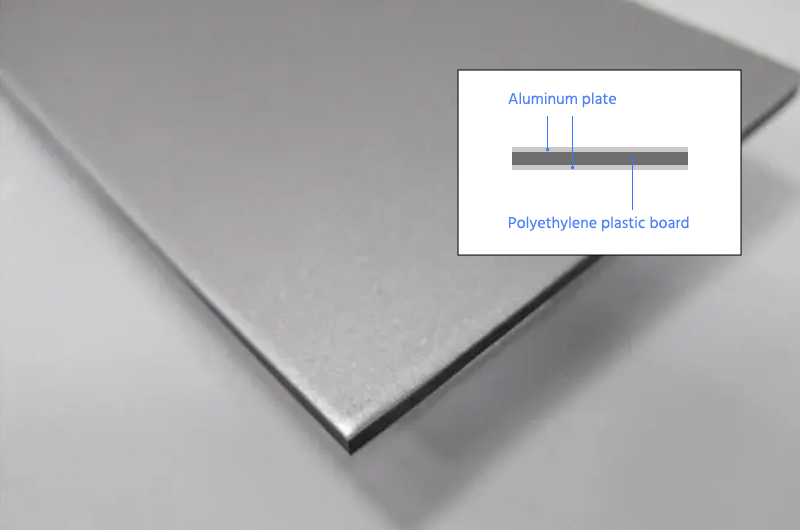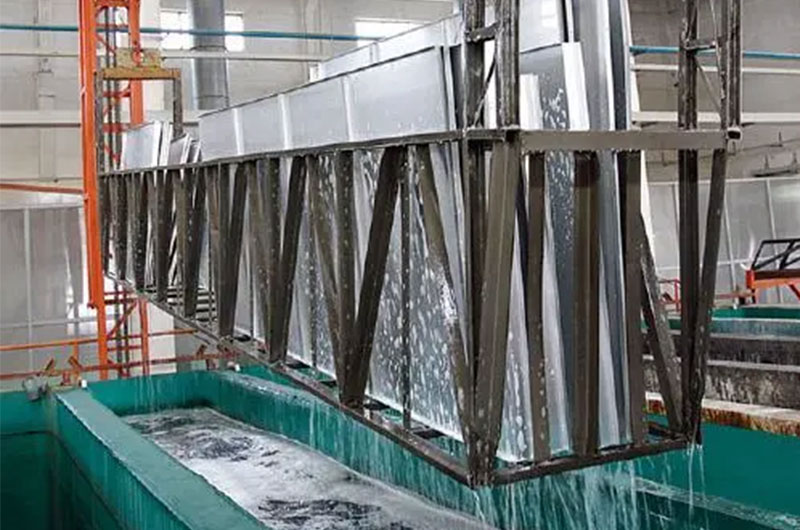Surface Treatment of Aluminum Sheet for Aluminum Composite Panel
Updated : Dec. 13, 2023Aluminum-plastic panel, also known as aluminum-plastic composite panel, abbreviated as aluminum-plastic panel, is a new type of material composed of aluminum panels that have undergone surface treatment and coated with baked paint as the surface layer, and polyethylene plastic panels as the core layer, processed through a series of technological processes.
The aluminum-plastic panel is formed by the bonding and extrusion of two types of materials, metal and non-metal. If the aluminum sheet is not pre-treated and used directly, it will result in poor composite quality, low peeling strength, or instability, ultimately significantly affecting overall performance.
Therefore, surface treatment is an important step before the coating of aluminum-plastic composite panels.
Why is surface treatment necessary before coating with aluminum strip for aluminum-plastic panels?
Aluminum-plastic panels use aluminum strips, and surface treatment before coating is necessary for several reasons.
In the production process, aluminum strips are coated with lubricants and anti-oxidants for technological requirements. During transportation, they may also accumulate some dirt, affecting their adhesion and bonding properties; hence, thorough cleaning is necessary.
After undergoing surface treatment, the aluminum strips develop a dense chemical protective film on the surface. This chemical film enhances adhesion, improving the coating's bonding to the aluminum surface and the corrosion resistance of the aluminum-plastic panel surface.
It also boosts the aluminum strip's anti-oxidation capability, thereby extending the lifespan of the paint coating.

Surface treatment process of aluminum strip before coating
Degreasing -> Rinse -> Conversion Coating -> Rinse -> Water Removal -> Drying -> Rinse -> Neutralization -> Rinse
1. Degreasing is performed through immersion. When aluminum sheets pass through the degreasing solution, the degreasing agent separates the grease from the aluminum sheet, floating it on the surface of the tank.
2. It is then removed through the overflow outlet and filtered in the degreasing filtration tank. The filtered solution is pumped back to the original tank.
3. The degreasing temperature should be around 40°C ± 10°C, and the conversion temperature should be around 30°C ± 5°C.
4. Regularly monitor changes in the concentration of each tank solution and adjust by adding water or replenishing chemicals as needed.
5. The alkaline cleaning tank is equipped with nozzles and brush rollers. When the aluminum sheet passes through, hot water is sprayed through the nozzles, and the stubborn grease is removed with brushes.
6. Using a spray method, pressurized clean water is sprayed to wash away grease and contaminants from the aluminum sheet.
7. Strongly absorbent water-removing rollers are used to squeeze and remove water from the aluminum sheet. Alternatively, two sets of air knives can be used to blow away residual water from the aluminum sheet using compressed air.
8. High-temperature airflow generated by electric heating is used to thoroughly dry the residual moisture on the surface of the aluminum sheet.
Failure to control parameters such as temperature, concentration, processing time, and solution renewal during the treatment process can impact the quality of cleaning.

Aluminum strip degreasing and oil removal
During the rolling process, aluminum coil surfaces may have lubricants or grease. Therefore, in the pretreatment stage, it is essential to remove grease and other adherents.
Currently, there are many methods for oil removal. Based on the characteristics of grease in the aluminum coil processing, the nature of surface contaminants, and the required processing characteristics, alkaline or acid cleaning methods are commonly chosen.
Acid cleaning for aluminum strip
Acid cleaning involves using acidic solutions with highly efficient surfactants to remove grease and clean the aluminum coil at room temperature. Simultaneously, it mildly corrodes the aluminum surface to enhance adhesion during the coating process.
This method is suitable for cleaning thin sheets or those with light oil stains. For thicker sheets or heavier oil stains, alkaline cleaning is recommended.

Alkaline cleaning for aluminum strip
The alkaline solution's degreasing process involves the saponification of animal and vegetable oils and the emulsification of various oils (including mineral oil). In the alkaline solution, fats undergo saponification, forming water-soluble soaps and glycerol, which are then removed.
Other fats on the aluminum surface, such as Vaseline and lubricants, cannot undergo saponification but can form an emulsion under certain conditions, removing them from the aluminum surface. A substance that facilitates the formation of emulsions for various fats is called an emulsifier (a type of surfactant).
Commonly used alkaline degreasers internationally often contain ingredients such as trisodium phosphate, sodium silicate, and surfactants.
Trisodium phosphate
It has good buffering and certain surfactant properties, providing excellent rinsing properties.
Sodium silicate
It has good surfactant properties. When combined with other surfactants, it becomes the best emulsifier and dispersant among alkaline substances.
Surfactants
In alkaline degreasing, the adhesion between oil contaminants and the aluminum surface weakens due to the action of surfactants. Under external stirring, the oil gradually separates from the aluminum surface, forming small spherical shapes, eventually turning into an emulsion.
After alkaline degreasing and etching, the aluminum surface may have some black or gray oxides and residual alkali. Therefore, the aluminum sheet's surface after alkaline cleaning must undergo neutralization treatment to remove any remaining substances.
Chemical conversion treatment of aluminum strip before coating
The purpose of chemical conversion treatment is to create a protective film on the surface of the aluminum strip, preventing further corrosion and ensuring good adhesion of the newly formed protective film.
For aluminum-plastic composite panels, the commonly used aluminum sheet is pure aluminum or an alloy aluminum containing a small amount of elements such as silicon, iron, copper, manganese, magnesium, and zinc.
To assess the effectiveness of the conversion treatment on aluminum sheets more intuitively, chromates, along with a small amount of phosphoric acid, sulfuric acid, or nitric acid, are often used as conversion agents.
Hydrofluoric acid and potassium salts are used as accelerators to generate a new conversion film. Due to the involvement of other ions in the reaction in the alloy, the surface color appears colorless to light green, allowing the thickness of the conversion film to be judged by surface color.

Storage after chemical conversion treatment of aluminum strip before coating
Since the conversion film oxidizes over time, aluminum sheets after conversion treatment, including those after coating, should not be stored for too long. If storage is necessary, they should be sealed or subjected to other anti-oxidation treatments.
The main reason for the bubbling of aluminum-plastic panels after composite is the use of aluminum sheets that have been stored for too long and have undergone oxidation.
Quality standards for surface treatment of aluminum strip before coating
- After degreasing, the surface of the aluminum sheet is clean, free of visible oil stains, and the surface does not bead water after washing.
- After neutralization, the aluminum sheet surface is clean and free of discoloration.
- After conversion, the aluminum sheet surface forms a complete and uniform film.
- After drying, the aluminum sheet surface is dry without water stains and appears light green upon visual inspection.
Good surface treatment is crucial to ensuring the performance of aluminum-plastic panels and contributes to their extensive use in the construction industry.





